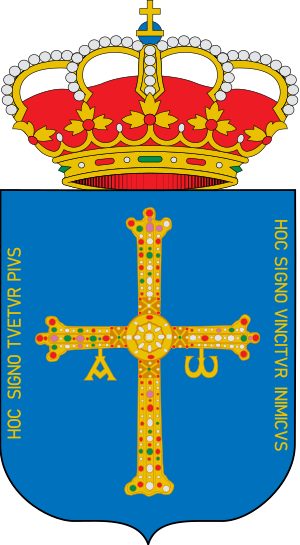Victory Cross facts for kids
Quick facts for kids Cruz de la VictoriaVictory Cross |
|
|---|---|

Picture of the Santa Cruz de la Victoria.
|
|
| Material | Various (incl. gold, gems). |
| Created | Early Middle Ages (c. 908 AD; core claimed from 8th century) |
| Present location | Cámara Santa, Cathedral of San Salvador of Oviedo |
The Victory Cross (in Asturian and Spanish: Cruz de la Victoria) is a special jeweled cross from the early 900s. It was given by King Alfonso III of Asturias to the Cathedral of San Salvador in Oviedo, Asturias, Spain. King Alfonso III ruled from 866 to 910.
This cross was made in the year 908 at the Castle of Gauzón in Castrillón, Asturias. Inside the fancy outer layer is a wooden cross made of oak. A famous story says this wooden cross was carried by King Pelagius of Asturias during the important Battle of Covadonga.
Today, the flag of the modern region of Principality of Asturias shows the Victory Cross. It has been on the flag since December 1990.
Contents
The Story of the Victory Cross
There's a legend about the wooden part of this cross. It says that the plain wooden cross was carried by King Pelagius of Asturias when he fought against the Muslim people of al-Andalus at the Battle of Covadonga. This battle was very important for the start of the Kingdom of Asturias.
Later, King Pelagius's son, Favila of Asturias, supposedly kept the cross. He built the Church of Santa Cruz de Cangas de Onís in 737. This church was dedicated to the True Cross and was in Cangas de Onís, which was the first capital of the Kingdom of Asturias.
However, in 2010, scientists used a special test called radiocarbon dating. They found that the wooden cross is from the late 800s. This means it was made around the same time as its beautiful outer casing.
How the Cross Was Made
The outer part of the cross is covered with 152 real and imitation gems. An inscription on the cross tells us that this fancy casing was made at the Castle of Gauzón in Asturias in 908.
King Alfonso III gave this important gold artwork to the Cathedral of Oviedo. He did this to celebrate 100 years of victories and conquests for the Asturian kingdom. This cross is a great example of Pre-Romanesque art.
Repairs and Restoration
Over the years, the Victory Cross has needed many repairs. During a big conflict called the Spanish Civil War, the Cross, like other valuable items in the Cámara Santa, was seriously damaged. It needed a lot of work to be fixed.
From 1942 onwards, the Cross got its gems back thanks to people donating money. Goldsmiths Horacio Rivero Alvarez and Luis Aguilar worked on it. Later, in 1971, a German goldsmith named Werner Henneberger added new enamel parts.
On August 9, 1977, the Cross, along with two other important items (the Agate box and the Cross of the Angels), was harmed. Some parts were taken, and the precious stones and gold plating were damaged. The way the Cross looks today is thanks to a very careful repair job done in 1978.
What the Cross Looks Like
The Victory Cross is shaped like a Latin cross. It measures about 92 centimeters (36 inches) tall and 72 centimeters (28 inches) wide. The inside is made of two pieces of oak wood, each about 2.5 centimeters (1 inch) thick. These pieces have round ends that finish in three leaf-like shapes, and they are joined in the middle by a round disk.
The entire cross is covered with thin sheets of gold and fancy gold wire designs called filigree. It is very richly decorated, especially the front side. The front is covered with colorful enamel, pearls, precious stones, and gold thread.
The back of the cross has an inscription written in gold letters. This inscription tells us who gave the cross to the Church of San Salvador: King Alfonso III and Queen Jimena. It also mentions where it was made (Gauzón Castle) and the year it was finished. The inscription says:
Svsceptvm Placide Maneat Hoc In Honore Di Qvod Offervnt
Famvli Xpi Adefonsvs Princes Et Scemena Regina
Qvisqvis Avferre Hoc Donaria Nostra Presvmserit
Fvlmine Divino Intereat Ipse Hoc Opvs Perfectvm Et Concessvm Est
Santo Salvatori Ovetense Sedis
Hoc Signo Tvetvr Pivs Hos Signo Vincitvr Inimicvs
Et Operatvm Es In Castello Gavzon Anno Regni Nsi XLII
Discvrrente Era DCCCLXVI A
This Latin inscription roughly translates to: "May this offering, which the servants of Christ, Prince Alfonso and Queen Jimena, offer, remain peacefully in God's honor. Whoever dares to take away our gifts, may he perish by divine lightning. This work was completed and granted to the Holy Savior of the See of Oviedo. By this sign the pious is protected, by this sign the enemy is conquered. And it was made in Gauzón Castle in the 42nd year of our reign, in the year 866 (of the Spanish Era, which is 908 AD)."
See also
 In Spanish: Cruz de la Victoria para niños
In Spanish: Cruz de la Victoria para niños



